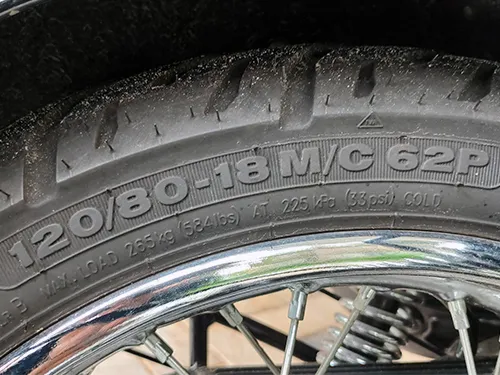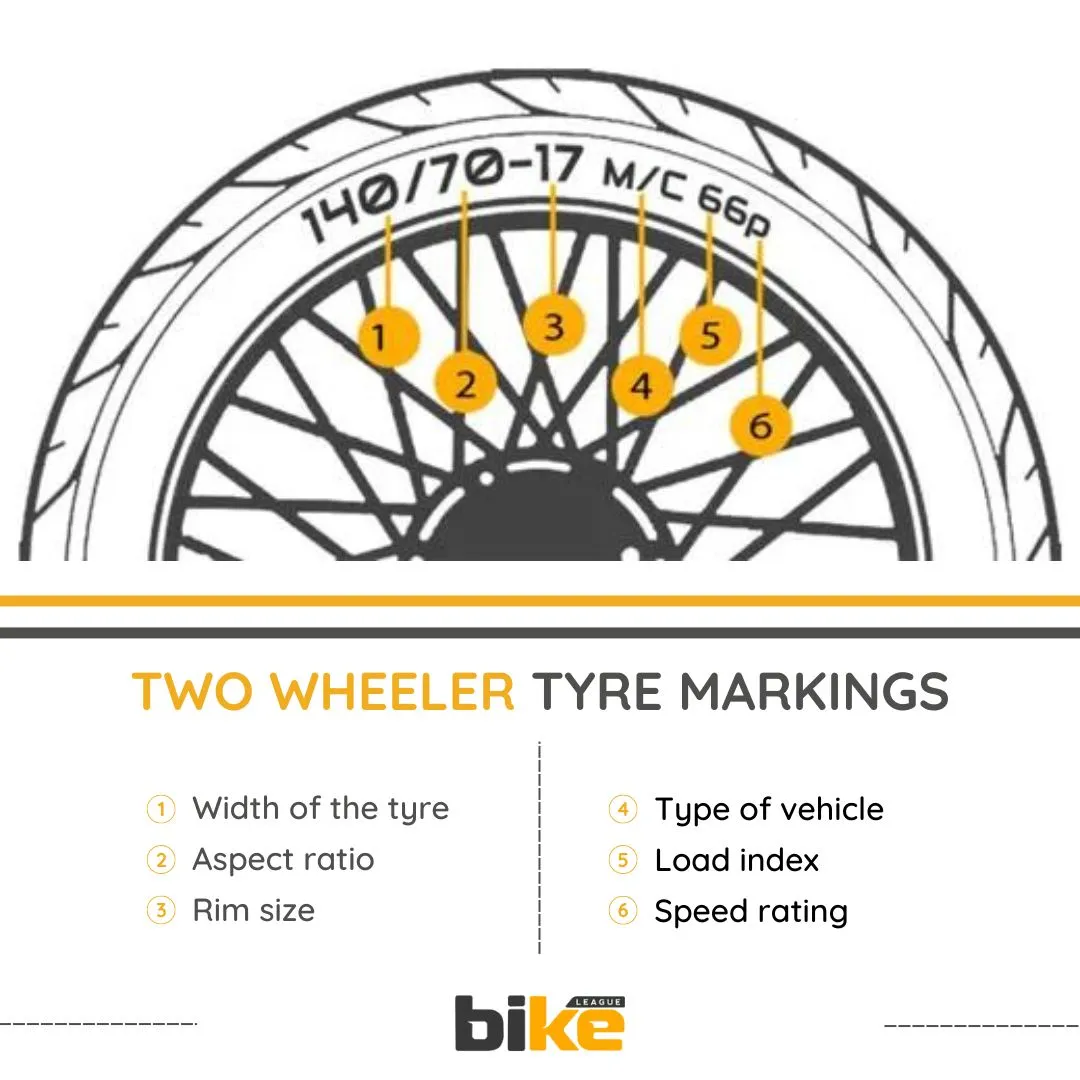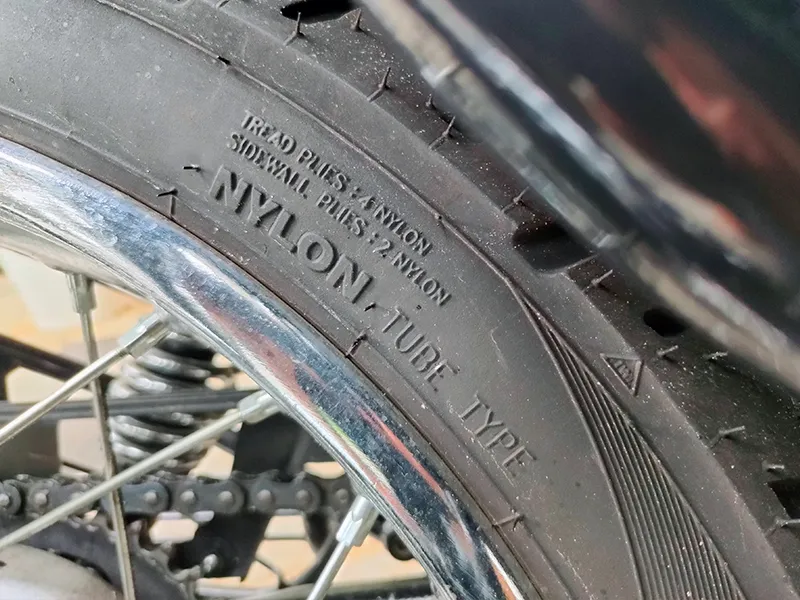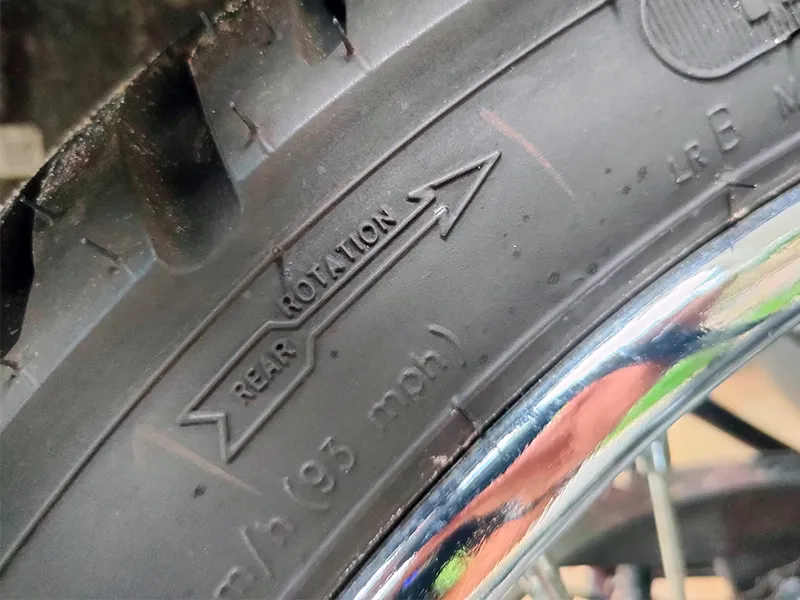
Long story short – To sum up, don’t pick two-wheeler tyres based only on the brand. It’s essential to understand tyre sizing and how to interpret motorcycle tyre codes. Just like shoes are important for us, wheels are important for your bike. When choosing a tyre, look at the speed rating, rim size, load index, and other key details. We’ll explain these points here.
When your bike’s original tyre wears out or you want to change to a new set, it’s essential to consider more than just the brand. Always read the motorcycle tyre code or markings carefully before buying. The tyre code tells you everything you need to know. It’s also helpful to check customer feedback and get advice from workshop technicians.
When checking tyre compatibility, you should always read the motorcycle tyre code/markings to verify the width, aspect ratio, and construction type of the bike tyre. If a wrong set of tyres is installed, it affects performance, stability, and safety. Let us make things easier for you with clear pictures and simple explanations.
Straight to the matter. Let’s delve deep into how to read motorcycle tyre code/markings and what you should prioritise. There are five main values that we need to look at. They are :
- Width of the tyre
- Aspect ratio (between height and width)
- Rim size
- Type of vehicle
- Load index
- bike tyre Speed rating
The picture shows the bike tyre markings on a real two-wheeler tyre.
Two-wheeler tyre code deciphered
1. Width of the tyre
The first two or three digits of the bike tyre markings mention the width in millimetres with correct tyre inflation. 140 is the width in our above image.
2. Aspect Ratio
The next digits represent the height mentioned as a percentage of the tyre’s width. Lower aspect ratios (e.g., 40, 50) indicate sportier tyres with shorter sidewalls for better handling and grip. Higher aspect ratios (e.g., 60, 70) offer more comfort and stability for everyday riding.
It is 70 in our image, meaning the tyre sidewall’s height is 70% of the width.
3. Type of construction (Not always present)
Found along with the rim size, which explains the construction method used for tyre manufacturing.
- B – bias belt or bias ply construction (older design, less common)
- D – Diagonal tyres (less common, combines bias and radial features)
- R – Radial tyres (most common, offer better handling and comfort)
4. Type of Vehicle
M/C in above image means motorcycle.
5. Rim size
Digits adjacent to the construction type mention rim size or wheel diameter in inches. 17 is the rim size of the tyre in the above pic.
6. Load Index of two-wheeler tyre
As the name suggests, it is the maximum weight the two-wheeler tyre can hold or carry. In the above image, it is 66. Check below motorcycle tyre load index chart
| Load Index | Load in Kg |
|---|---|
| 62 | 265 |
| 63 | 272 |
| 64 | 280 |
| 65 | 290 |
| 66 | 300 |
| 67 | 307 |
| 68 | 315 |
| 69 | 325 |
| 70 | 335 |
| 71 | 345 |
| 72 | 355 |
| 73 | 365 |
| 74 | 375 |
| 75 | 387 |
7. Speed rating
Maximum speed at which the tyre can operate; Upgrading to a higher speed rating tyre can improve your bike’s stability at high speeds. Check the bike tyre speed rating chart below
| Code | km/h |
|---|---|
| A1 | 5 |
| A2 | 10 |
| A3 | 15 |
| A4 | 20 |
| A5 | 25 |
| A6 | 30 |
| A7 | 35 |
| A8 | 40 |
| B | 50 |
| C | 60 |
| D | 65 |
| E | 70 |
| F | 80 |
| G | 90 |
| J | 100 |
| K | 110 |
| L | 120 |
| M | 130 |
| N | 140 |
| P | 150 |
| Q | 160 |
| R | 170 |
| S | 180 |
| T | 190 |
| U | 200 |
| H | 210 |
| V | 240 |
| Z | over 240 |
| W | 270 |
| (W) | over 270 |
| Y | 300 |
| (Y) | over 300 |
8. Additional Markings
- Tubeless (TL) or Tube-Type (TT): Indicates whether the tyre requires a tube or not.
- Direction of Rotation: An arrow showing the intended direction of tyre rotation for optimal performance.
- Tread Wear Indicators (TWI): Small raised bars inside the tread grooves indicate the legal wear limit.
- Date Code: A four-digit code indicating the week and year of manufacture (e.g., “2234” means the tyre was made in the 34th week of 2022).
How can I ensure that the tyre I select is compatible with my specific motorcycle model?
When selecting a tyre for your motorcycle, consider the following recommendations.
- Follow Manufacturer Recommendations: Check your motorcycle owner’s manual or the manufacturer’s website for the recommended tyre size, load index, speed rating, and whether you need tubeless or tube-type tyres.
- Match Tyre Size Exactly: Use tyres that match the recommended width, aspect ratio, and rim diameter. Choosing the wrong size can affect your bike’s stability, suspension, and handling.
- Load Index and Speed Rating: Ensure the load index meets or exceeds the minimum specified for the bike, considering both solo and pillion riding conditions common in India.
- Compound and Pattern: Select a tyre compound and tread pattern that performs well on Indian roads, including rain, dust, and rough surfaces.
- Buy from Authorised Dealers: Purchase your tyres from authorised dealers to ensure they’re genuine and properly rated. This also helps protect your warranty and safety.
- Professional Fitment: Have a professional install your tyres to ensure they’re balanced, aligned, and inflated correctly, which is especially important for high-performance bikes.
What are the consequences of using the wrong tyre size on my motorcycle?
Choosing the wrong tyre size for your motorcycle can make riding less safe, affect how your bike handles, and wear out parts faster. It can also lead to a rougher ride and even cause legal or insurance problems.
- Compromised Handling and Stability: Oversized tyres can make your motorcycle feel heavier and harder to control, especially when turning or riding straight. Tyres that are too small reduce grip, especially when accelerating or riding at high speeds, which can make handling feel unstable.
- Engine and Braking Performance: Larger tyres put extra strain on your engine and brakes, making your bike slower to speed up and harder to stop. Smaller tyres can get too hot and wear out faster, which also makes riding less safe.
- Component Damage and Tyre Wear: If your tyres are too big, they might rub against parts like the fenders or swingarm, causing damage. Using the wrong size can also cause the tread to wear unevenly or prematurely, which increases the risk of blowouts and makes your ride bumpier.
- Speedometer/Odometer Inaccuracy: Using larger tyres without recalibrating your speedometer and odometer can result in under-reporting of speed and mileage, potentially leading to legal compliance issues.
- Riding Comfort: The wrong tyre size can make your ride feel rougher, with more bumps and vibrations reaching you, especially if the tyres don’t match what your bike’s suspension is built for.
- Legal and Insurance Risks: Fitting non-standard tyre sizes may violate Indian Motor Vehicle rules and can invalidate insurance claims in the event of an accident. Always use manufacturer-specified sizes to ensure compliance and insurance.
FAQ about how to read two-wheeler tyre code
1. What does the “B” mean on a two-wheeler tyre?
The letter “B” on a motorcycle tyre code/markings can have two different meanings, depending on the context:
1. Bias-ply construction:
In the traditional tyre construction of bike markings, “B” stands for “bias-ply.” This refers to the tyre’s internal structure, where fabric cords are laid diagonally across the carcass (like a belt), offering a strong and stable construction.
2. Bias-belted construction:
Sometimes, “B” can also stand for “bias-belted” construction. This is a hybrid design that combines bias-ply and radial features.
2. What does 67h mean on a two-wheeler tyre?
The “67H” marking on your motorcycle tyre is a combination of two separate codes: the load index (67) and the speed index (H). The load index number indicates the maximum weight the tyre can safely carry at its recommended inflation pressure. The speed index letter denotes the maximum speed the tyre is rated for when carrying its maximum load.
Myths and misconceptions about two-wheeler tyre code
Myth 1: Tyres with a Higher Speed Rating Always Perform Better
Reality: A higher speed rating of a bike tyre does not necessarily mean better performance for everyday riding. Speed ratings indicate the maximum speed a tyre can handle. For high-performance bikes, selecting a tyre with a suitable speed rating is crucial for safety. Still, other factors, such as tread design and rubber compound, are more critical for performance.
Myth 2: Tyres with a Higher Load Index Provide Better Handling
Reality: The load index indicates the maximum weight a tyre can support, not its handling characteristics. While it is essential to choose a tyre with an appropriate load index for your vehicle, it does not directly correlate with better handling.
Myth 3: Tyres with a Lower Aspect Ratio Are Always Better for Performance
Reality: Lower aspect ratio tyres can improve handling and stability, but they also make the ride stiffer and less comfortable. The choice of aspect ratio should strike a balance between performance needs and comfort.
Myth 4: Tyres with a Larger Diameter Always Improve Performance
Reality: Larger diameter tyres can affect the bike’s handling and speedometer accuracy. Sticking to the manufacturer’s recommended tyre size is essential for optimal performance.
Myth 5: Tyre Rotation is Not Necessary
Reality: Regular tyre rotation helps in even wear and extends the tyre’s life. Neglecting tyre rotation can lead to uneven wear and reduced performance.
Other related articles from Bikeleague India
- Best bike tyre brands for your motorcycle in India
- Bike Tyre Polish in India: Elevate your Tyre look Now
- Motorcycle Sprocket & Gear Ratios – The Ultimate Guide
- Electric scooter maintenance – Top tips for longevity
- ADMS DB
Conclusion
Most motorcycle owners need to pay more attention to the details and avoid being fooled or lured by technicians in shops and showrooms. So, all you have to do is learn how to read bike tyre markings from this article and stay safe on your motorcycle. As mentioned at the beginning of the article, tyres are like shoes, so the correct size matters. Last but not least, always wear a helmet and follow road rules. To avoid confusion about tyre purchases, read this bike tyre code article carefully.
If you have any other doubts or queries, email us at bikeleague2017@gmail.com. You can also share your doubts or opinions in the comments section below. We are always eager to help and assist you. Additionally, there are several social media platforms associated with Bikeleague India that may raise your suspicions.




